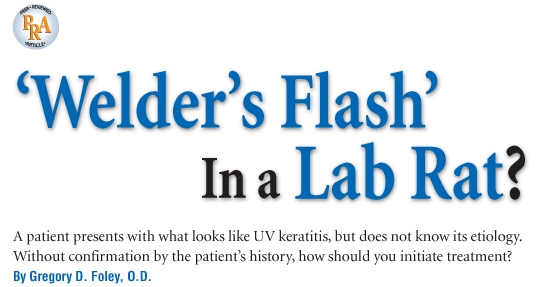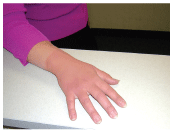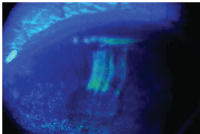
We have all been taught that a good history is the most important part of the clinical visit. Remember: 90% of the diagnosis is made in the history, and the clinical exam only confirms what we suspect.
If the condition eludes an exact diagnosis, treat the basic signs at their root causes (traumatic, infectious or inflammatory, or possibly a combination of them). The situation may become clearer as time progresses. The following is just such a case.
History
A 32-year-old white female presented urgently. She reported that she is a second-shift worker in the cytology lab at a local hospital, and while on her dinner break last night, her eyes began to burn and water. They reddened, and the pain intensified throughout the evening.
After dinner, she went to the ER to ask an attending doctor his opinion. He diagnosed bilateral iritis and gave her a bottle of 1% cyclogel to be dosed at one drop every six hours.
She presented to my office first thing the next morning, complaining of a painful burning sensation in both eyes all night. She had a towel over her eyes and was driven to the office by her mother. She reported that she didnt wear contact lenses or eye glasses. She also reported good systemic health and no recent history of viral or inflammatory illness.
Diagnostic Data
On examination, her uncorrected visual acuity was 20/200 O.U. Pinhole acuity was 20/50 O.U. Pupils were pharmacologically dilated and minimally reactive. Extraocular motilities were full and intact. Slit lamp examination displayed mild lid edema and erythema. I noted significant conjunctival hyperemia.
The most outstanding finding: grade 3+ superficial punctate keratitis (SPK) O.U., which stained brightly with sodium flourescein dye. There was no follicular reaction, no petechial hemorrhages or foreign bodies on lid eversion, and no anterior chamber reaction. No preauricular or submandibular lymph node enlargement was present.
Her intraocular pressure measured 18mm Hg O.U. The fundus examination was unremarkable. I told her that she did not have an iritis and that much of the blurred vision she was experiencing was due to the cycloplegic agent. I instructed the patient to discontinue the drops.
History Repeating

The patients hands appeared sunburned after her shift at the cytology lab.
The patients severe bilateral keratitis resembled many cases of ultraviolet (UV) keratitis, also known as welders flash keratitis, that Id treated in the past. So, I decided to revisit the patients history after explaining to her what I saw. I asked if she was exposed to someone who was welding. She denied such a possibility. She also denied using a tanning bed or lamp.
I asked if she worked around any germicidal light bulbs. She reported that they were used in other departments of the hospital laboratory, but not in her section. Shed had no contact with new chemicals or fumes that could have caused exposure keratitis. There was nothing in her history to suggest any exacerbation of preexisting dry eye, nor was there any history that would point to an infectious etiology.
The only change she had noted in her work environment was a brighter bulb mounted under the cabinet at her workspace. She reported that a new coworker who shared the same workstation during the first shift had complained that the lighting was too dim. A brighter bulb was installed in their stationour only red flag.
Her face and hands looked mildly sunburned. We discussed the need for her to investigate her work station.
Diagnosis
I diagnosed this patient with UV keratitis, likely due to exposure to a germicidal bulb in the cytology lab.
Treatment and Follow-Up
Based on my past clinical experience in managing UV keratitis, as well as my literature-based knowledge of how this condition classically presents, I believed that this was most likely a case of UV keratitis. The patients history could not confirm the diagnosis at this point, but I initiated treatment with that in mind.
We discussed the likelihood that she had UV keratitis, probably from exposure to a germicidal bulb within the laboratory. I asked her to mentally revisit the previous day and see if she could isolate the exposure. I told her that in another 24 hours, she would probably feel better, thanks to the fast-healing nature of the corneal epithelium.
I placed her on TobraDex (tobramycin/dexamethasone, Alcon) one drop q3h to reduce the inflammation and increase comfort. Thanks to the doctor in the ER, she was already cyclopleged. I also told her to use preservative-free tears hourly, and I gave her a sample of Refresh PM ointment (Allergan) to use just before bed.
I asked her to return in 24 hours for follow-up, and recommended that she use an oral over-the-counter NSAID (e.g., ibuprofen) for pain relief and ice packs for the mild lid erythema and edema.
The patient returned the next day and reported that she was in much less pain. The redness had decreased, and her vision was much sharper. She now demonstrated an uncorrected acuity of 20/30 O.U. Slit lamp examination revealed marked improvement, with only trace injection of the conjunctiva and minimal residual SPK.
I updated her treatment regimen. My new instructions were to decrease the TobraDex to q.i.d. O.U. for another four days, and then discontinue it altogether. She was instructed to continue using the non-preserved tears p.r.n. for scratchiness.
The patient went on to inform me that she had done her homework. While she was at home recuperating, she asked her coworkers to examine the various light bulbs around the cytology lab, especially the new bulb in her workstation. It turned out that the new coworker at her workstation had taken it upon herself to find a brighter bulb. At the end of her first shift, she found what she thought was a standard fluorescent bulb from the stock closet and replaced the dim bulb herself.
It turns out that she used a germicidal bulb. At this facility, standard hospital protocol is to call maintenance for bulb changes to ensure things are done properly. But, as we now knew, that did not happen here. My patient was the first person to use the workstation with the new bulb.
The patient and I were both gratified to know the etiology of her keratitis. I felt good knowing that I had trusted my clinical judgment on the presentation of her signs and that I had pushed the patient to find the source of UV radiation.
Discussion

Another patient presented with UV keratitis caused by the rays emitted from a tanning booth.
Courtesy: Randall Thomas, O.D.
Ultraviolet light is invisible to the human eye. It is part of the electromagnetic spectrum, beyond the visible spectrum. It is further divided into wavelength ranges: UV-A, UV-B and UV-C. UV-A rays range from 315nm to 400nm.1 UV-B, which causes sunburn, falls between 280nm and 315nm. Lastly, UV-C (100nm to 280nm) is germicidal at 253.7nm and produces ozone at 185nm. The cornea is most sensitive to photodamage in the UV spectral range of 260nm to 280nm, with peak absorption at 270nm.1-4
In the workplace, UV light comes in the form of welders arcs, germicidal lights, high-pressure lamps, electronics, survey equipment, etc. At home, it can be found in the form of sunlamps, tanning booths, and of course, naturally occurring sunlight.5
A germicidal bulb, the culprit in this case, emits radiation in the UV-C range. These bulbs can be bought from commercial bulb suppliers and are commonly used for sterilization.
Typically, UV keratitis presents with a slight-to-moderate decrease of best-corrected acuityin the range of 20/25 to 20/50. Associated conjunctival injection is also usually noted. The cornea displays a diffuse haziness, but no evidence of an abrasion or erosion. The flourescein staining pattern reveals diffuse stippling with pinpoint uptake.5 The presence of foreign bodies must be ruled out by lid eversion.
Therapy can range from an antibiotic-steroid combination to topical antibiotic drops or ointments. Cycloplegia reduces the risk of internal ocular inflammation. A clinician may patch the eye or use bandage lenses. Analgesics may help control the pain during the first 24 hours.6 The best management considers the patients need for functionality for the first 24 to 48 hours while recuperating.
As primary-care optometrists, we are frequently the first to evaluate and treat patients who have experienced phototrauma. But, we are also in an excellent position to educate our patients about how to prevent phototrauma and protect their ocular surface tissues.
Dr. Foley is a partner at Eye Central, with offices in
1. Bergmanson JP, Sderberg PG. The significance of ultraviolet radiation for eye diseases. A review with comments on the efficacy of UV-blocking contact lenses. Ophthalmic Physiol Opt 1995 Mar;15(2):83-91.
2. Millodot M, Earlam RA. Sensitivity of the cornea after exposure to ultraviolet light. Ophthalmic Res 1984;16(6):325-8.
3. Mitchell J, Cenedella RJ. Quantitation of ultraviolet light-
absorbing fractions of the cornea. Cornea 1995 May;14(3):266-72.
4. Young RW. The family of sunlight-related eye diseases. Optom Vis Sci 1994 Feb;71(2):125-44.
5. Jones TR, Gillen JP. Ultraviolet light-induced keratitis secondary to germicidal lamp exposure resulting in corneal epithelial sloughing. Am J Emerg Med 1992 Sep;10(5):508-9.
6. Sutphin JE. Basic clinical science course: external disease and cornea. Section 8.











